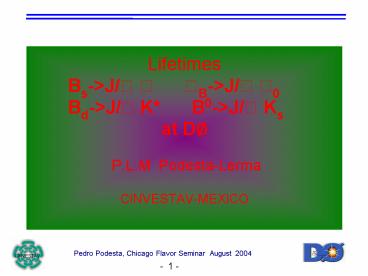Lifetimes - PowerPoint PPT Presentation
1 / 39
Title:
Lifetimes
Description:
Pedro Podesta, Chicago Flavor Seminar August 2004. CINVESTAV - 1 - Lifetimes. Bs- J/ B- J ... Pedro Podesta, Chicago Flavor Seminar August 2004. CINVESTAV - 4 ... – PowerPoint PPT presentation
Number of Views:54
Avg rating:3.0/5.0
Title: Lifetimes
1
- Lifetimes
- Bs-J/? ? ?B-J/? ?0
- Bd-J/? K B0-J/? Ks
- at DØ
- P.L.M Podesta-Lerma
- CINVESTAV-MEXICO
2
Outline
- Motivations
- Topology
- Data
- Cuts
- Fitting technique
- Systematics
- Crosschecks
3
Motivationsb-baryon discrepancy
4
Motivations Current measurements
5
4 track Vertex Topology
Lxy XB- Xprim
J/?
?
LBxy Lxy pTB pTB
?-
c?B ?B LBxy (MB/pTB)
K
Bs(Bd)
?(K)
SV 40 ?m
K-(?-)
PV 20 ?m
6
3 track Vertex Topology
J/?
?
?-
p(?)
?B(Bd)
?0(Ks)
7.9 (2.9) cm
?-(?-)
SV 40 ?m
PV 20 ?m
7
J/? ? ??-
- J/? cuts
- J/? mass 2.9,3.25 GeV
- Smt hits in muon 1
- Distance from PV to J/psi vertex
- Al least one PV reconstructed
- Track measurements downstream (and misses upstream (
8
? ? KK-
- ? cuts
- Mass windows 1.008,1.032 GeV,
- 2 opposite charge tracks that make a vertex of 4
tracks with the Jpsi vertex - SMT hits 0 for each track
9
K? K?-
- K cuts
- Mass windows (0.85,0.93) GeV
- 2 opposite charge tracks that make a vertex of 4
tracks with the Jpsi vertex - SMT hits 0 for each track
10
?? K?-
- cuts
- Mass windows (0.85,0.93) GeV
- 2 opposite charge tracks that make a vertex of 4
tracks with the Jpsi vertex - SMT hits 0 for each track
11
Ks??-?
- Ks cuts
- Mass windows (0.85,0.93) GeV
- 2 opposite charge tracks that make a vertex of 4
tracks with the Jpsi vertex - SMT hits 0 for each track
12
PDF models
- Mass Model
- SM Gaussian
- BM First(Second)-order polynomial background
- Resolution Model
- Gaussian using event-per-event lifetime error
s scale factor
13
PDF models
- Lifetime models
- SLF Signal lifetime PDF
- Convolution(Exponential decay, Resolution)
- BLF Background lifetime PDF
- Resolution negative exp. decay 2 positive
exp. decays - 2Dim PDF
14
Lifetime distribution models
?
2
15
(No Transcript)
16
(No Transcript)
17
N 61 12 Events
?B-J/? ?0
18
N 291 23 Events
B0-J/? Ks
19
Systematics
- Use J/? vertex instead of B vertex.
J/psi Vertex
- Run with a different geometry.
Alignment
- Use toy MC to test or Fit code.
Fitting
- Use a quadratic polynomial in Mass
- Convolute exponentials
- Use two decays for long lifetime.
- Cross feed contamination Bs?Bd
Background
- Use different Model for resolution
Resolution
20
J/? Vertex
For ideal B candidates, B and J/? vertex should
be equal. J/?vertex may be inaccurate when two
tracks are very close (collinear). We got a
sytematic errors of 3 ?m for Bs and 4 ?m for Bd.
Preliminary
21
Background
We have that the c? distributions from the
sideband. Hi and Low are not equal. Sytematic
Error of 3 ?m for Bs, Bd.
Fitted PDL Low(left) and High(right) mass
regions for the Bd
22
Fitting Code
- We generated a 1000 samples with the Bs PDF, and
parameters. We fit using same code. This told us
how well our fitting method is.
Bs
Bd
Difference 0.3 0.9 ?m
Difference 0.2 0.5 ?m
23
Cross-feed contamination (estimated from MC)
??b(J/??)
B0(J/?Ks)
24
Systematics summary
25
MC studies
- Our vertexes is working. Errors are meaningful.
- Find a possible bias
Vertex studies (Pulls and resolutions)
- Make the resolution studies
- Cross feed Bs Bd
- Estimate linearity of our Fit.
Fit in a Bs, Bd MC sample.
Fit in J/psi X Inclusive MC sample
- Long Lifetime component, better understanding of
the background.
26
Understanding Long Lifetime Background I
Signal
Hi
Low
27
Understanding Long Lifetime Background II
28
consistency studies
Full analysis test
We have tested our code in a full simulated MC
sample . For the Bs the input was 439 ?m . We
got 437.3 /- 5.4 ?m , same behavior was
observed for Bd .
Red All contributions, Green signal, blue
combinatorial mainly from misreconstruted.
29
consistency studies
Range of Mass selection
Dependence of the Mass
All D0 mass peak are slightly shifted due to
magnetic and material uncertainties, instead of
use the PDG mass in the PDL definition (slide )
we use the central value of our fit . We found a
difference of 0.75 microns.
30
Different Cuts an split samples
We have explored two additional set of cuts , 1)
Maximum S/B (low statistics), 2)Maximum yield
(large background). We also split the sample in
several ways.
c?(Bd) ?m
c?(Bs) ?m
Check
31
Linearity
In a Full simulated MC, we fit using various
lifetimes inputs. Our results are consistents
with linear.
Test of linearity of the lifetime fit, Left Bs
MC, right Bd MC.
32
Sumary Results I
- With approximately 220 pb-1 in DØ detector
up to february2004. We reconstructed 337(1370)
Bs(Bd) candidates and we have measured the
lifetime. - ?(Bs) 1.444 0.098 (stat) 0.020 (syst)
ps. - ?(Bd) 1.473 0.052 (stat) 0.023 (syst)
ps. - And the ratio
- ?(Bs)/?(Bd) 0.980 0.075 (stat) 0.003
syst - D0 conference and analysis notes at
- http//www-d0.fnal.gov/cinvestav/d0_private/Anal
ysis/Bs/Bs.html
-0.090
-0.050
-0.070
33
Comparison
The current world best single measurement.
34
Summary results II
35
In progress
- Add more available data.
- Bd, Bs Angular analysis, integrated in the time.
- Bs, Bd time dependent Transversity Analysis.
- Bs lifetime in the semileptonic channel.
36
Backup slides
37
Data Samples
- Luminosity 220 pb-1
- Remove all bad data.
38
Mass Distributions with a c?/?(c?) 5
Bs-J/? ?
Bd-J/? K
Preliminary
Preliminary
N 1028 36
N 259 14
39
Establishing the ?b signal
(1)
(2)
(3)
(4)

